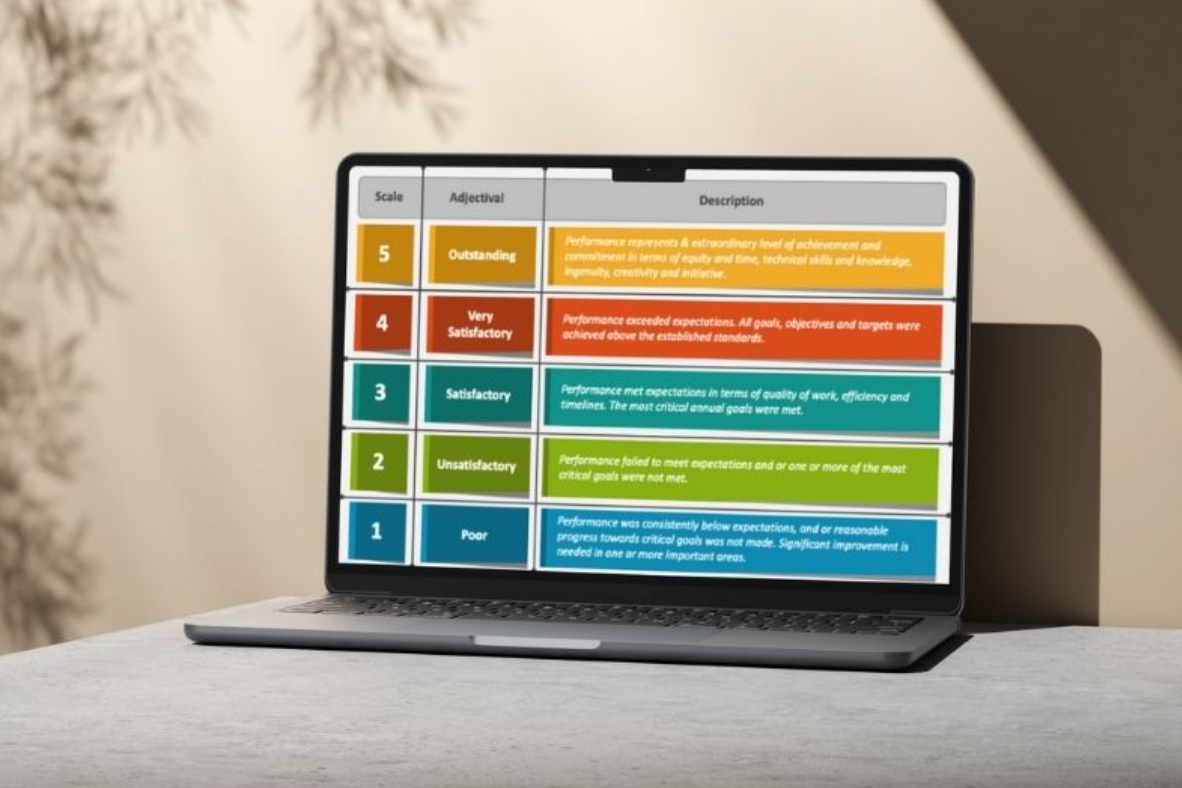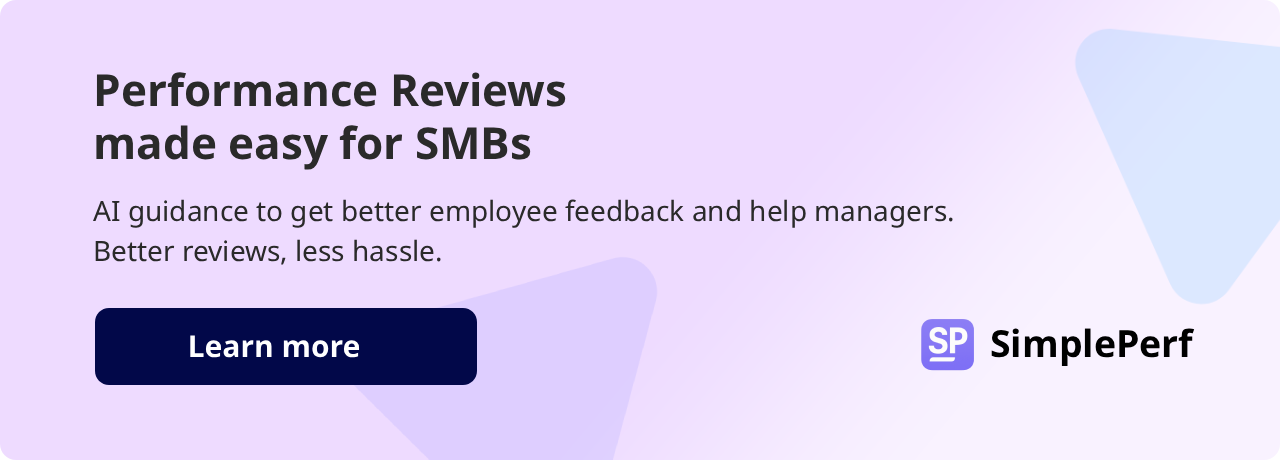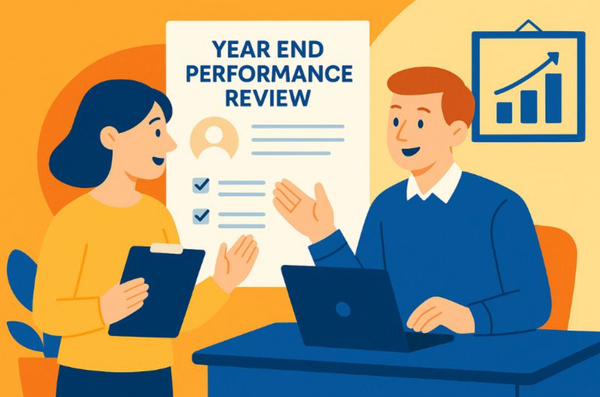Pros and Cons of Ratings in Performance Reviews
Discover the pros and cons of using ratings in performance reviews. Learn how they impact employee motivation, fairness, and feedback effectiveness in your organization.


Performance reviews are the cornerstone of employee development and organizational growth, and many companies use a rating system to access employee performance. This is often in the form of a numerical or categorical scale (e.g., 1-5, ‘meets expectations’ to ‘exceeds expectations’). While these ratings can streamline the performance review process, they also come with challenges that may impact employee morale, productivity, and fairness.
We discuss the pros and cons of ratings in employee performance evaluations, helping businesses to determine whether this approach aligns with business goals and culture dynamics.
Pros of using ratings in performance reviews
A rating system brings a number of benefits to the performance appraisal process, such as standardization, simplicity, data-driven decision making, the facilitation of compensation, and employee accountability.
1. Standardardization and objectivity
A performance rating scale creates a structured and standardized performance appraisal system. This consistency ensures all employees are assessed using the same criteria, reducing subjectivity and potential bias from managers. Objectivity is a foundational performance management criteria that must be present in the workplace to avoid decreased employee morale and dissatisfaction, and when implemented correctly, ratings can foster better employee relations and performance.
Example:
A company employs 25 sales people with different skill levels, but evaluates them according to the same business objectives. They set up a 5-point rating scale and assign criteria to each point. Data is collected from the existing CRM and employee engagement apps on a monthly basis to allocate the correct score.
The employee performance ratings are completed according to factual information that is verified by the manager, eliminating any bias. The ability of the employee to evaluate their own performance using these metrics, creates a sense of ownership and satisfaction for the employee, because everything is done in a transparent manner.
2. Efficiency and simplicity
A numerical or categorical rating system (like the one above) simplifies the performance appraisal process, making it faster for managers to assess performance without writing lengthy evaluations. This efficiency is particularly beneficial for large organizations where reviewing hundreds of employees would otherwise be a time-consuming task. Time is freed up for managers and employees to concentrate on business objectives.
Example:
A supervisor with 50 direct reports can quickly verify ratings by pulling reports from existing systems, instead of writing detailed monthly, or quarterly feedback for each individual. Formal performance reviews become about discussing growth and development, rather than an administrative burden.
3. Data-driven decision making
A scoring system allows businesses to rate employee performance over time, enabling data-driven decisions about promotions, raises, and training needs. HR teams can analyze performance trends to identify high performing employees, underperformers, and areas requiring intervention.
When performance rating data is readily available this reduces the time needed to gather information for annual employee performance reviews (which is the biggest and most important review of the year for many companies), because the information is already complete.
One of the biggest challenges in gathering performance data has been subjective ratings such as customer interactions, colleague feedback, and the employees own culture positive behavior. However, this is speedily being addressed by employee engagement apps, like BuddiesHR, that keep ‘subjective’ metrics between colleagues, managers, and other departments, turning the whole process into sometime far more concrete.
4. Facilitates compensation and promotion decisions
Companies who use a performance rating system have found the feedback process goes more smoothly, and makes way for constructive discussions about compensation and promotion. A Harvard Business Review noted that one-third of U.S. companies are moving away from an annual documented administrative evaluation to more frequent, informal check-ins, and faster rewards for employees who do good things.
Employees with higher ratings can receive better rewards, and are more motivated to work towards them when they are transparently discussed, and allocated according to a rating system.
Example:
A company tells its product development team that if they achieve a 4 or 5 rating in their annuals performance reviews, they will receive a guaranteed salary increase of between 10-15%, and an additional bonus of $1,000 for each month they score a 5. This motivates the employees to exceed performance expectations and ensures company success.
5. Encourages employee accountability
Evaluating employee performance according to specific criteria, and linking it to compensation, makes it more likely that they will take ownership for business objectives. Clear expectations and measurable outcomes helps employees to understand the minimum performance standards, and encourages a performance management system based on merit.
It must be noted that the measurement scale must reflect what is in the realm of possibility. It may seem tempting to make the jump between a 4 rating and 5 rating quite large, so you can encourage great performance. However, if getting to the next rating is completely unachievable for the employee it will do nothing but demotivate them, or push them towards burnout.
Cons of using ratings in performance reviews
The performance rating scale is not a perfect solution for all jobs, and industries. The cons involve oversimplification of performance, a ‘check-box’ mentality, potential for inconsistency, favoritism of high-rating employees, and a disconnect to training and development objectives.
1. Oversimplification of performance
A holistic performance management system cannot reduce complex employee contributions to a single number or category. Many roles in business involve subjective and qualitative factors that may not easily be captured in a numerical rating.
For instance, a nursing sister may be evaluated objectively on factors such as safety and care of patients, effectiveness of patient management, and the use of established care systems. However, a large portion of the work involves the subjective experience of the patients, such as treatment success, complaints, cleanliness, competence, and good interpersonal relations.
For these kinds of jobs, a rating scale may not be an accurate reflection of performance.
2. Encourage a ‘check-box’ mentality
When ratings become the primary focus, managers can rush through performance reviews, simply assigning scores rather than engaging in meaningful discussions around growth and development.
Also, employees that just want to do enough to get by may start using the rating system as a way to only focus on objectives that are measured, and neglect other important day-to-day activities such as administrative tasks. Just ticking off performance doesn’t encourage creativity, participation in development opportunities, or increased satisfaction.
Example:
A manager meets with each of her employees to discuss the annual performance rating. She quickly assigns a 3 (meets expectations) to all her staff and does not provide any constructive feedback. Her team is left feeling that performance discussions were rushed, and lacking valuable insights into improvement. As a result, the high performing team members become discouraged, and the underperforming team members see no reason to improve.
3. Potential for bias and inconistency
Despite the goal of objectivity, ratings can still be influenced by personal biases, recency effects, and favoritism. Different managers may interpret broad, or poorly defined rating scales incorrectly, leading to inconsistencies across teams.
Personal biases can also appear where rating scales are well-defined but are not agreed upon by the manager due to either favoritism, or interpersonal issues with a staff member. The manager either wants to increase the rating without evidence, or wants to downgrade the rating due to negative bias. Unfortunately, this does happen, especially where rating systems have never been used, and performance has been largely subjective. It can be hard for people to change their perspective.
Example:
A sales manager might give top ratings to a favorite salesperson year after year, even if their teamwork, adaptability, and customer ratings have declined, while overlooking employees who have significantly contributed in other important ways.
4. Can encourage focus on only developing high performers
Reviewing performance according to a rating system can sometimes affect the focus a manager has on employees, where they begin to concentrate their efforts on developing higher performers, and neglect the training needs of those scoring lower ratings. This can create resentment among team members, and a polarization of the team.
Numerical scales can only ever be a tool, and should not become a reason for unfair treatment. The employee with a lower rating could be lacking key skills and experience needed to improve their performance, and with a little help, they might join the ranks of the high-performers.
5. Disconnect between ratings and future potential
A major drawback of ratings-based employee evaluations is that they focus on past performance rather than future growth. Employees receive a number or category, but may not have a clear path on how to develop their skills further or advance in the company. For example, a call centre agent with future leadership aspirations may have no way to prove their capability for leadership while being measured on contact centre KPIs.
Even if performance rating systems are highly developed and accurately depict past, and current performance, there must be an evaluation method for future potential that is used alongside it.
6. Creates a competitive rather than collaborative environment
When employees are rated against each other rather than against objective criteria it can create an overly competitive atmosphere, discouraging teamwork and collaboration. This happens when the rating system is done on a grading basis.
In this system, a set number of employees have to be allocated a certain rating. This can lead to unfairness and an inaccurate reflection of performance, but it also fosters competition because people are competing against one another, rather than with one another to achieve company goals.
Companies that are very focused on the ‘bell-curve’ system of allocating annual increases often experience such challenges. According to this system the company can only have a certain number of employees in higher categories because they have set compensation limits.

A better alternative to rating systems: A hybrid review system
Given the challenges of a purely ratings-based performance appraisal system, some companies are adopting a hybrid approach which includes a variety of tools, measuring different performance elements.
A hybrid appraisal system may look something like this:
How employee engagement apps can boost a hybrid review system
In a hybrid performance review system, subjectivity can become a weak link, but so can a lengthy and document driven process. To counter both these pitfalls:
- Automate as many evaluations as you can (such as the competency, peer, and 360s) by using software that is specifically geared for this.
- Then implement employee engagement apps which integrate with your communication (like Slack), and provide analytics for employee performance reviews.
BuddiesHR has developed a suite of fun, engaging, and highly effective employee engagement apps for businesses that want to track important metrics without it becoming a burden. Their apps provide the following advantages:
- They can be used as a single module, or an ‘all-in-one’ suite.
- They fully integrate with Slack. If this is where your company communication is happening already - you don’t need to buy another platform. If you don’t use Slack, why not? You’re missing out on great employee engagement apps that can make your life much easier.
- The apps have been built by HRs for HR.
- The signup only has 3-steps. Click, click, click. Done.
Conclusion
While ratings in performance reviews offer clear benefits such as standardization, efficiency, and data-driven decision-making, they also come with potential downsides, including oversimplification, bias, and a lack of focus on future growth. The key takeaway for businesses is that no single system is perfect—what works best depends on company culture, industry, and workforce dynamics.
A well-balanced approach, such as a hybrid review system that combines quantitative ratings with qualitative feedback and future-focused discussions, can provide a ‘best-in-class’ alternative to a ratings system.





